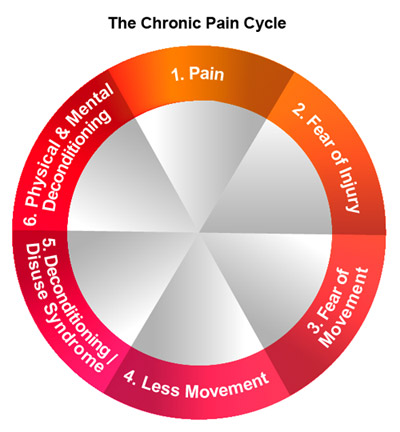Chronic Pain Cycle
Chiropractor Anna Papadopoulou Explains What Chronic Pain Is.
Have you ever considered the reasons that perpetuate chronic pain? Why has it been there for so long? How can you be fine for a few months but it re-occurs with increased intensity, or the frequency is higher?
Chronic pain occurs when an acute injury fails to recover on time and successfully move to the healing process, because of mechanical, chemical or emotional re-aggravation.
Let’s have a look at this process using an example.
A 34-year-old lady is in a hurry, misses a step and goes over on her ankle. The ankle swells and she is unable to walk on it. The doctor tells her keep active but to rest and ice the ankle to reduce the inflammation.
If the lady is careful enough and follows some supportive rehabilitation after the acute inflammation has subsided then she has a good recovery prognosis. However, anxieties, catastrophizing, concerns and fears around pain generated by her mind initiate avoidance or over protective behaviours.
Without using the ankle and weight baring at the correct time in the healing process, her brain becomes increasingly more sensitive to the right ankle because there is not enough feedback from it. In an attempt to increase the feedback here brain will reduce the pain threshold.
So, now even gentle pressure or walking that should not normally be painful is now painful (this is called allodynia). Further behavioural changes compound the problem. Becasue of the lower pain threshold it is less likely that she will walk into town or take the dog for that walk.
Her movement is restricted and there is less freedom in what movements she does initiate. Her muscles are now trying to adapt to the novel avoidant forces. More collagen is put down to strengthen her muscles in response. This leads to the formation of more adhesions, compounding reduced movement and flexibility.
Without a change to the cycle sensitivity will keep increasing and the pain threshold will keep decreasing, perpetuating the cycle of chronic pain.

A key factor for change is increasing function and movement within the joint to facilitate the breakdown of the adhesions through chiropractic manipulation, accompanied by reassurance and education surrounding pain and the meanings we bring to it.
Local circulation improves, sensory feedback to the brain increases, the brain increases pain thresholds resulting in greater movement and flexibility. The aim is obviously to run the pain cycle in reverse.
As we can see, chronic pain is complex becasue it involves the interplay of tissue damage, our brain’s perception and response to pain, and the meanings our minds bring to the experience of pain.
The ankle example above can be extrapolated to neck pain and headaches, low back pain and repetitive strain injuries of extremities such as tennis elbow or plantar fasciitis (a disorder that results in pain in the heel and bottom of the foot).
Anna Papadopoulou
Chiropractor

